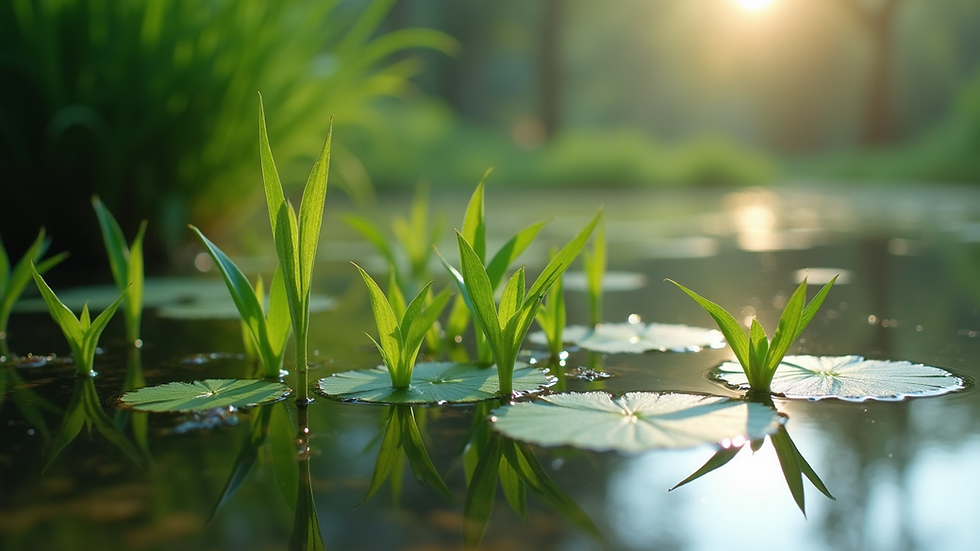Keeping Your Pond Clean for Swimming
- Jack Wooller
- Nov 4
- 4 min read
Creating a pond that is not only beautiful but also safe and clean for swimming is a rewarding project. I’ve learned that maintaining a swimmable pond requires a mix of regular care, smart design, and a bit of patience. Whether you have a natural swimming pond or a constructed one, keeping the water clear and healthy is essential. In this post, I’ll share practical tips and insights to help you enjoy your pond all season long.
Understanding the Basics of Swimmable Pond Cleaning Tips
Before diving into the cleaning routine, it’s important to understand what makes a pond suitable for swimming. Unlike traditional pools, natural swimming ponds rely on biological filtration and plants to keep the water clean. This means fewer chemicals and a more eco-friendly approach.
Here are some key points to keep in mind:
Filtration system: A good filtration system is the heart of a clean pond. It usually includes mechanical filters to remove debris and biological filters to break down harmful substances.
Plants: Aquatic plants act as natural filters by absorbing nutrients that algae feed on. They also provide oxygen and create a balanced ecosystem.
Water circulation: Proper water movement prevents stagnation, which can lead to algae growth and unpleasant smells.
Regular maintenance: Even the best systems need regular attention to remove debris, check water quality, and adjust equipment.
By focusing on these basics, you set a strong foundation for a clean and inviting swimming pond.

Essential Swimmable Pond Cleaning Tips for Clear Water
Keeping your pond clean is easier when you follow a consistent routine. Here are some practical tips that I use and recommend:
Skim the surface regularly
Leaves, twigs, and insects can quickly accumulate on the water surface. Use a pond skimmer or a fine net to remove debris at least once a week. This prevents organic matter from sinking and decomposing.
Maintain your filtration system
Check filters weekly and clean or replace filter media as needed. Mechanical filters trap particles, while biological filters support beneficial bacteria that break down waste.
Control algae growth naturally
Algae can turn your pond green and slimy. Introduce floating plants like water lilies or submerged plants such as hornwort to compete with algae for nutrients. Avoid overfeeding fish, as excess food can fuel algae blooms.
Test water quality regularly
Use simple test kits to monitor pH, ammonia, nitrate, and phosphate levels. Balanced water chemistry is crucial for swimmer safety and pond health.
Remove sediment and sludge
Over time, organic matter settles at the bottom. Use a pond vacuum or hire a professional to remove sludge annually. This reduces nutrient buildup that feeds algae.
Encourage natural predators
Frogs, dragonflies, and certain fish species help control mosquito larvae and other pests, contributing to a balanced ecosystem.
Limit chemical use
Avoid harsh chemicals that can harm plants, fish, and swimmers. If treatment is necessary, choose eco-friendly options and follow instructions carefully.
By following these steps, you’ll keep your pond inviting and safe for swimming throughout the warmer months.

How to Keep a Pond Clean for Swimming: Practical Advice
If you want to dive deeper into how to keep a pond clean for swimming, it’s helpful to think of your pond as a living ecosystem. Every element plays a role, and small changes can make a big difference.
Design with cleaning in mind: When building or renovating your pond, consider easy access for cleaning tools and equipment. Gentle slopes and clear zones for plants help maintain balance.
Seasonal care: Spring and autumn are critical times. In spring, remove winter debris and check equipment. In autumn, prepare for leaf fall and reduce feeding as temperatures drop.
Aeration: Adding an aerator or fountain increases oxygen levels, which supports beneficial bacteria and keeps water fresh.
Shade and sunlight: Too much direct sunlight encourages algae. Use floating plants or strategically placed trees to provide shade without blocking the entire pond.
These practical tips help you stay ahead of common problems and enjoy a crystal-clear swimming pond.
Tools and Equipment That Make Pond Cleaning Easier
Having the right tools can save time and effort. Here are some essentials I recommend:
Pond skimmer net: Lightweight and easy to use for daily debris removal.
Pond vacuum: Removes sludge and sediment from the bottom without draining the pond.
Water testing kit: Simple kits measure pH, ammonia, and other key parameters.
Biological filter media: Supports beneficial bacteria that keep water clean.
Aquatic plant scissors: Trim plants to prevent overgrowth and maintain balance.
Pond aerator or fountain: Improves oxygen levels and water circulation.
Investing in quality equipment pays off with less maintenance and healthier water. Regular use of these tools keeps your pond in top shape for swimming.
Enjoying Your Clean and Healthy Swimming Pond
Maintaining a swimmable pond is a rewarding experience. When you see the water clear and sparkling, it’s a sign that your efforts are paying off. Remember, patience is key. Natural ponds take time to balance, but with consistent care, they become a beautiful and refreshing retreat.
Here are a few final tips to enhance your pond experience:
Swim responsibly: Shower before entering to reduce contaminants.
Educate family and guests: Share simple rules to keep the pond clean.
Schedule professional check-ups: Experts can spot issues early and offer tailored advice.
Enjoy the wildlife: A healthy pond attracts birds, insects, and amphibians that enrich your garden.
By embracing these habits, you create a safe, enjoyable space for swimming and relaxation all year round.

Keeping your pond clean for swimming is a journey that combines nature, care, and a bit of know-how. If you want to learn more about how to keep a pond clean for swimming, check out expert resources and connect with specialists who understand the unique needs of ponds in Southern England. With the right approach, your pond can be a stunning, swimmable oasis for years to come.




Comments